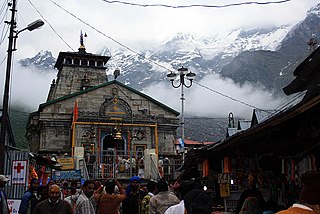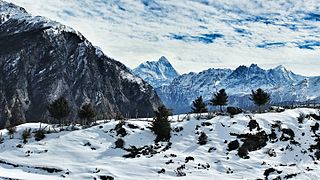Related Research Articles

The Himalayas, or Himalaya, is a mountain range in Asia, separating the plains of the Indian subcontinent from the Tibetan Plateau. The range has some of the Earth's highest peaks, including the very highest, Mount Everest. Over 100 peaks exceeding 7,200 m (23,600 ft) in elevation lie in the Himalayas.

Garhwal is one of the two administrative divisions of the Indian state of Uttarakhand. Lying in the Himalayas, it is bounded on the north by Tibet, on the east by Kumaon, on the south by Uttar Pradesh state, and on the northwest by Himachal Pradesh state. It includes the districts of Chamoli, Dehradun, Haridwar, Pauri Garhwal, Rudraprayag, Tehri Garhwal, and Uttarkashi. The people of Garhwal are known as Garhwali and speak the Garhwali language. The administrative center for Garhwal division is the town of Pauri. The Divisional Commissioner is the administrative head of the Division, and is a senior Indian Administrative Service officer. As the administrative head of the division, the Commissioner is overall incharge of the 7 districts in the Garhwal region of Uttarakhand, and is aided in his duties by an additional commissioner and the district magistrates. Sushil Kumar is the divisional commissioner of the Garhwal Division since December 2021.

Uttarakhand, also known as Uttaranchal, is a state in the northern India. It is often referred to as the "Devbhumi" due to its religious significance and numerous Hindu temples and pilgrimage centres found throughout the state. Uttarakhand is known for the natural environment of the Himalayas, the Bhabar and the Terai regions. It borders the Tibet Autonomous Region of China to the north; the Sudurpashchim Province of Nepal to the east; the Indian states of Uttar Pradesh to the south and Himachal Pradesh to the west and north-west. The state is divided into two divisions, Garhwal and Kumaon, with a total of 13 districts. The winter capital of Uttarakhand is Dehradun, the largest city of the state, which is a rail head. Gairsain, a town in Chamoli district, is the summer capital of Uttarakhand declared on 5 March 2020. The High Court of the state is located in Nainital, but is to be moved to Haldwani in future.
Kuti Valley is a Himalayan valley situated in the Pithoragarh District, Kumaon division of the Uttarakhand state of India. Located in the eastern part of Uttarakhand, it is the last valley before the border with Tibet. It runs along a NW to SE axis, formed by the river Kuti Yankti, which is one of the headwaters of the Kali River that forms the boundary between India and Nepal in this region.
The Bhotiya, also called Rongpa, are located in the trans-Himalayan region of India. Rongpa communities are some of the oldest and native of the upper belt of the Himalayas, close to the border of Tibet in Garhwal. It was once believed that the Rongpa community had been wiped out.

The Ladakh Range is a mountain range in central Ladakh in India with its northern tip extending into Baltistan in Pakistan. It lies between the Indus and Shyok river valleys, stretching to 230 miles (370 km). Leh, the capital city of Ladakh, is on the foot of Ladakh Range in the Indus river valley.

Purang or Burang, known as Puhreng in Tibetan, is a town which serves as the administrative center of Purang County, Ngari Prefecture of the Tibet Autonomous Region (TAR), China. The town lies at an altitude of 3,900m in the valley of the Karnali River. The town spans an area of 3,257.81 square kilometres (1,257.85 sq mi), and has a permanent population 6,047 as of 2010, and a hukou population of 4,477 as of 2018. To the south are Gurla Mandhata and the Abi Gamin ranges. Lake Manasarovar and Mount Kailash are to the north. This region is the mythological and actual river nexus of the Himalaya with sources of the Indus, Ganges and Yarlung Tsangpo/Brahmaputra all within 110 kilometres (70 mi) of Purang.

The Garhwali people are an Indian ethnolinguistic group native to the Garhwal, in the Indian state of Uttarakhand, who speak Garhwali, an Indo-Aryan language.
Bhotiyas are people of presumed Tibetan heritage that live along the Indo-Tibetan border in the upper reaches of the Great Himalayas, at elevations ranging from 6,500 feet (2,000 m) to 13,000 feet (4,000 m). In Uttarakhand, they inhabit seven river valleys, three in the Garhwal division and four in the Kumaon division. Their main traditional occupation used to be Indo-Tibetan trade, with limited amounts of agriculture and pastoralism. The customary Indo-Tibetan trade drastically stopped following the 1962 Sino-Indian war, and was resumed in the early 1990s under state-regulated mechanisms. These days, medicinal and aromatic plant collection is a major livelihood among this group, alongside by out-migration for education and jobs. Transhumance and pastoralism have drastically reduced in prevalence among this group too. They follow Hinduism and Buddhism and traditionally speak West Himalayish languages.

Uttarakhand has a total geographic area of 53,483 km2, of which 86% is mountainous and 65% is covered by forest. Most of the northern parts of the state are part of Greater Himalaya ranges, covered by the high Himalayan peaks and glaciers, while the lower foothills were densely forested till denuded by the British log merchants and later, after independence, by forest contractors. Recent efforts in reforestation, however, have been successful in restoring the situation to some extent. The unique Himalayan ecosystem plays host to many animals, plants and rare herbs. Two of India's great rivers, the Ganges and the Yamuna take birth in the glaciers of Uttarakhand, and are fed by myriad lakes, glacial melts and streams.
Malari in the Dhauli Ganga valley of the Nanda Devi Biosphere reserve is a small village near the Tibet border. This area has been declared as a world heritage site. Located 61 km from Joshimath, the nearest Tehsil, in Chamoli District of Uttarakhand.

Mana is a village in the district of Chamoli in the Indian state of Uttarakhand, located at an altitude of 3,200 meters. It is located on the northern terminus of National Highway 7, Mana is the first village before the Mana Pass and is 26 kilometres from the border of India and Tibet The village is at a distance of about 3 km from the Hindu Pilgrimage Badrinath and the two places are culturally connected with each other.

Gomati is a tributary of the Saryu River. The river originates in the higher reaches of Bhatkot northwest to the town of Baijnath in Uttarakhand, India. It joins Saryu at Bageshwar, which then proceeds towards Pancheshwar where it joins the Kali River.
Jeet Singh Negi was a music composer, singer, lyricist, writer and director from the Garhwal region of Uttarakhand, India. He is considered to be the father of modern Garhwali folk music.
Demchok , previously called New Demchok, and called Parigas by the Chinese, is a village and military encampment in the Indian-administered Demchok sector that is disputed between India and China. It is administered as part of the Nyoma tehsil in the Leh district of Ladakh by India, and claimed by China as part of the Tibet Autonomous Region.

The Sarju, also known as Sarayu, is a major river draining Central Kumaon region in the Indian state of Uttarakhand. Originating from Sarmul, Sarju flows through the cities of Kapkot, Bageshwar and Seraghat before joining Mahakali at Pancheshwar. The Sarju is the largest tributary of the Sharda River. The river forms the South-eastern border between the districts of Pithoragarh and Almora. Temperate and sub-Tropical forests cover the entire Catchment area of the River.
The Charding Nullah, traditionally known as the Lhari stream and called Demchok River by China, is a small river that originates near the Charding La pass that is also on the border between the two countries and flows northeast to join the Indus River near a peak called "Demchok Karpo" or "Lhari Karpo". There are villages on both sides of the mouth of the river called by the same name "Demchok", which is presumed to have been a single village originally, and has gotten split into two due to geopolitcal reasons. The river serves as the de facto border between China and India in the southern part of the Demchok sector.
Battle of Khurbura or Battle of Khudbuda also known as Gorkha-Garhwal War occurred in May 1804 near modern-day village of Dehradun, Khurbura 30.3256°N 78.0267°E. The battle is regarded as the first major attack in the history of Garhwal Kingdom that triggered between Kingdom of Nepal forces and Maharaja Pradyumna Shah, and continued for 13 days until the Garhwal king was defeated. It is chiefly regarded the only defeat of Pradyumna Shah's life and the victory of Gorkhali forces under Kingdom of Nepal.
Barahoti, also called Wu-Je or Wure, is a 1.5 square miles (3.9 km2) sloping plain located in the Indian state of Uttarakhand, Chamoli district. It is disputed by China, which also disputes a 750 square kilometres (290 sq mi) area surrounding it. The entire disputed area also goes by the name "Barahoti", or sometimes "Barahoti–Sangchamalla–Lapthal disputed area". The entire area is on the Ganges side of the Sutlej–Ganges water divide, which is also the current Line of Actual Control between India and China.
References
- 1 2 Negi, Sharad Singh (July 23, 2002). Cold Deserts of India. Indus Publishing. ISBN 9788173871276 – via Google Books.
- ↑ Wright, Colin. "The village of Niti, Kumaon (U.P.). 4 June 1812". www.bl.uk.
- 1 2 Nand, Nitya; Kumar, Kamlesh (July 23, 1989). The Holy Himalaya: A Geographical Interpretation of Garhwal. Daya Publishing House. ISBN 9788170350552 – via Google Books.
- ↑ Negi, S. S. (July 23, 1998). Discovering the Himalaya. Indus Publishing. ISBN 9788173870798 – via Google Books.
- ↑ Ethnomedicinal Plant Use and Practice in Traditional Medicine. IGI Global. March 13, 2020. ISBN 9781799813217 – via Google Books.